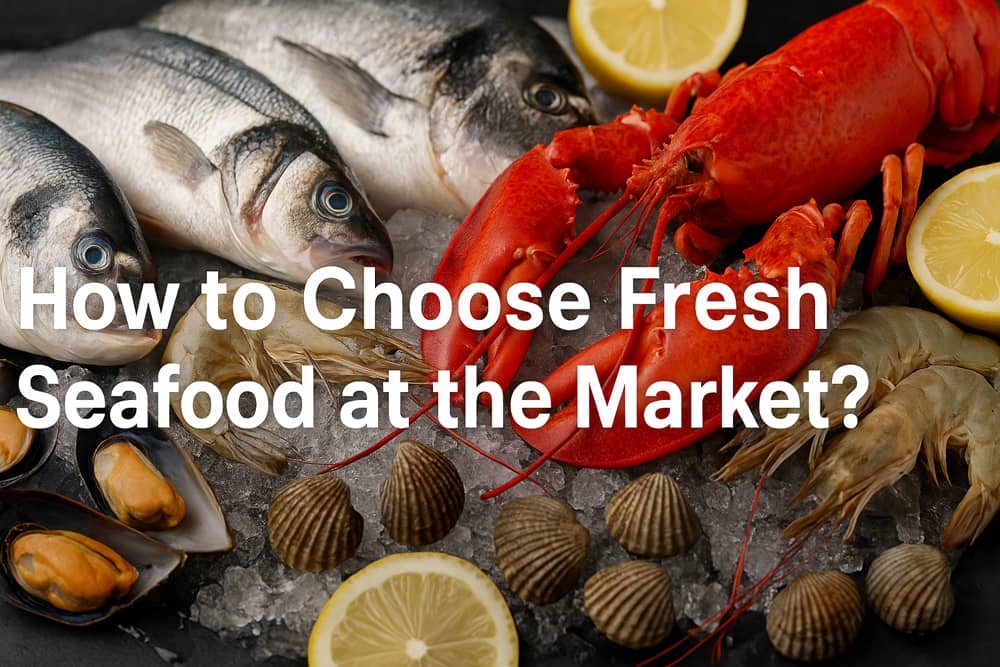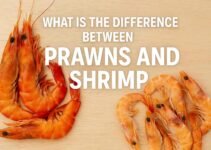Choosing fresh seafood at the market is essential for ensuring both food safety and premium taste. Consuming stale or contaminated seafood directly increases the risk of foodborne illnesses such as Vibrio infections and scombroid poisoning. Additionally, poor seafood quality negatively affects texture, flavor, and nutritional value. Fresh fish, shellfish, and crustaceans contain higher concentrations of beneficial nutrients like omega-3 fatty acids and essential minerals.
In today’s fast-paced markets, sellers often use display tricks to make older seafood appear fresh. Without the right knowledge, consumers can easily fall for visual deception. This comprehensive guide provides clear, science-backed methods to help you confidently evaluate seafood freshness based on appearance, smell, and texture. Whether you’re buying salmon, shrimp, or live shellfish, each section offers precise, actionable steps. By the end of this guide, you will make informed seafood purchases, avoid health risks, and enjoy the best flavors every time.
Contents
- 1 What Are the Key Indicators of Freshness in Seafood?
- 2 How to Check the Freshness of Different Types of Seafood?
- 3 Are There Specific Signs That Indicate Seafood Is No Longer Safe to Eat?
- 4 How Should You Interact with Market Vendors to Get the Freshest Seafood?
- 5 How Does the Seasonality of Seafood Affect Freshness and Availability?
- 6 How Important Is the Supply Chain in Determining Seafood Freshness?
- 7 What Are the Common Misconceptions About Buying Fresh Seafood?
What Are the Key Indicators of Freshness in Seafood?
Fresh seafood always displays three clear indicators: vibrant appearance, clean ocean-like smell, and firm texture. These attributes apply across all seafood categories, including fish, shellfish, and crustaceans.
How Do Appearance and Color Reveal Seafood Freshness?
To assess freshness based on appearance, look for bright, metallic skin and clear, bulging eyes in fish. Fresh fish should not have dull scales or sunken eyes. Shellfish, including clams and mussels, must have tightly closed shells. If shells are slightly open, perform the tap test—fresh shellfish will close immediately when tapped.
For crustaceans like shrimp and crabs, the shell should appear glossy, without any black spots or discoloration. Avoid seafood with faded colors, dry patches, or slimy surfaces, as these indicate spoilage.
What Does a Fresh Seafood Smell Like?
Fresh seafood smells like the ocean—clean, slightly briny, and never pungent. A strong, sour, or ammonia-like odor indicates bacterial growth and spoilage. For example, spoiled shrimp emit a sharp, unpleasant smell due to protein breakdown and bacterial activity.
Always perform a close sniff test before purchasing. If any acidic or overpowering scent is detected, the product is not fresh and should be avoided immediately.
How Can You Use Texture to Assess Freshness?
To assess texture, press the seafood gently with your finger. Fresh fish and shrimp will spring back immediately, leaving no indentation. Soft or mushy flesh indicates protein degradation and spoilage.
For shellfish, the shells must feel heavy and unbroken. A light, hollow feel suggests the animal inside is dead or missing. In crustaceans, a firm shell and tightly curled tail (in shrimp) are reliable indicators of freshness.
How to Check the Freshness of Different Types of Seafood?
Different seafood types require specific freshness checks. Use targeted inspection methods for fish, shellfish, and crustaceans to ensure safety and optimal taste.
How to Select Fresh Fish at the Market?
To choose fresh fish, inspect the eyes, gills, and flesh carefully. Fresh fish have bright, clear, and bulging eyes. Sunken or cloudy eyes indicate aging. Gills should appear vibrant red or pink and free from slime. Brown or gray gills are a clear sign of spoilage.
Check the flesh by pressing gently; it must spring back without leaving a mark. Also, examine the belly area. Avoid fish with bloated or burst bellies, as this suggests internal bacterial activity and decomposition.
How to Identify Fresh Shellfish Like Mussels and Clams?
Fresh shellfish must have tightly closed shells or react immediately when tapped. If the shells remain open after tapping, discard them as the animal inside is dead.
For live shellfish, the weight is a strong freshness indicator. Fresh shellfish feel heavy and full. Light shells often mean the meat has shrunk or decomposed. Also, avoid any shells with cracks or chips, which compromise the safety of the meat inside.
What Are the Signs of Freshness in Shrimp and Prawns?
To select fresh shrimp and prawns, focus on shell color, odor, and body firmness. The shell should be translucent and shiny without black spots or yellow discoloration. A strong or sour odor indicates protein breakdown and bacterial contamination.
Additionally, inspect the tails. Fresh shrimp have tightly curled tails, a sign they were alive or processed quickly after harvesting. Avoid shrimp with limp, straight tails, as this suggests delayed processing and potential spoilage.
Are There Specific Signs That Indicate Seafood Is No Longer Safe to Eat?
Spoiled seafood shows clear visual, olfactory, and textural warning signs. Recognizing these indicators helps prevent foodborne illnesses and ensures only safe products reach your kitchen.
What Are the Visual Signs of Spoiled Seafood?
Spoiled seafood often displays dull, faded colors and slimy surfaces. In fish, cloudy eyes, pale gills, and flabby bellies indicate bacterial degradation. Crustaceans like shrimp may show black spots on the shell, which signal decomposition.
For shellfish, open shells that remain unresponsive to tapping indicate the animal is dead and unsafe to eat. Avoid any seafood with unusual discoloration, bloating, or visible mold growth. These are definitive spoilage signs.
What Are the Common Odors That Signal Seafood Spoilage?
A strong ammonia-like smell is the clearest indicator of spoiled seafood. Fresh seafood emits a clean, oceanic scent, while spoiled products release sour, rancid, or overpowering odors.
In shrimp and prawns, a sharp, unpleasant chemical smell signals protein breakdown. Fish with a putrid odor, even if visually appealing, must be avoided. Always trust your sense of smell; if it smells bad, it is bad.
How Should You Interact with Market Vendors to Get the Freshest Seafood?
Direct engagement with seafood vendors increases your chances of accessing fresher products. Experienced vendors often reserve premium items for discerning buyers who ask the right questions.
What Key Questions Should You Ask the Vendor?
Ask vendors these three critical questions:
- “When was this seafood delivered?” – Fresh seafood should ideally be sold within 24 hours of delivery.
- “Was this seafood previously frozen?” – Knowing this helps set proper expectations about freshness and shelf life.
- “Do you have any recommendations for the freshest catch today?” – Vendors often guide loyal customers to the best options not immediately visible on display.
How Can You Negotiate for Better Quality and Price?
To negotiate effectively, shop near the end of market hours when sellers are motivated to clear inventory. However, prioritize products still meeting freshness criteria.
Establish rapport by becoming a repeat customer. Vendors tend to reserve higher-quality items for familiar faces. Combine loyalty with polite but firm negotiation to secure both premium quality and fair pricing.
How Does the Seasonality of Seafood Affect Freshness and Availability?
Seafood harvested in its natural season offers peak freshness, nutritional value, and better prices. Out-of-season products often undergo long storage or freezing, which reduces quality.
Which Seafood Types Are Best Bought During Specific Seasons?
- Salmon: Peak freshness from May to September.
- Oysters: Best from September to April following the “R” month rule.
- Crabs: Typically freshest between October and January.
- Shrimp: Best harvested between May and August.
Buying in-season ensures the seafood is naturally abundant, recently harvested, and less likely to have been frozen or stored long-term.
How Can You Use Seasonal Charts to Plan Purchases?
Use seafood seasonality charts to align your buying habits with harvest cycles. These charts help plan meals around peak freshness periods, ensuring better taste and nutritional content.
Many sustainable seafood organizations provide detailed charts online. Keep one accessible on your phone or print a copy for quick reference during market visits.
How Important Is the Supply Chain in Determining Seafood Freshness?
The seafood supply chain directly impacts product freshness through transportation speed, handling conditions, and cold chain management. Delays or improper storage during any stage degrade quality before reaching the market.
How Does Transportation Time Impact Seafood Quality?
Seafood transported within 24 to 48 hours after harvest maintains optimal freshness. Longer transport times increase exposure to temperature fluctuations and microbial growth, accelerating spoilage.
Airfreight is the fastest and most reliable option for preserving freshness, while overland and sea freight often involve extended storage times. Always ask vendors about the origin and transport duration of their products to assess freshness accurately.
What Certifications or Labels Indicate Proper Cold Chain Management?
Look for certifications such as HACCP (Hazard Analysis Critical Control Point) and BRCGS (Brand Reputation Compliance Global Standards). These labels confirm that the seafood has been processed and transported under strict temperature controls.
Additionally, seafood labeled with “flash-frozen at sea” indicates immediate freezing after harvest, preserving freshness and nutritional value. Such certifications provide assurance of consistent cold chain management, reducing the risk of spoilage.
What Are the Common Misconceptions About Buying Fresh Seafood?
Many buyers rely on outdated or incorrect beliefs when evaluating seafood freshness, leading to poor purchasing decisions. Recognizing these misconceptions helps avoid unnecessary health risks and ensures better quality.
Is Frozen Seafood Always Less Fresh Than Freshly Displayed Seafood?
Frozen seafood is not necessarily less fresh than what’s labeled “fresh.” High-quality frozen seafood is often processed and frozen immediately after harvest, locking in nutrients and flavor.
In contrast, “fresh” seafood on display may have been sitting for several days and previously frozen without disclosure. Prioritize properly frozen products over poorly handled “fresh” seafood when freshness is uncertain.
Are Shiny Eyes and Bright Colors Always Reliable Freshness Indicators?
Shiny eyes and bright colors are not foolproof signs of freshness. Vendors often enhance visual appeal by rinsing seafood with cold water or applying ice.
Prioritize olfactory and textural checks over appearance. Fresh seafood always smells clean and briny, and the flesh or shell feels firm and resilient. Do not rely solely on visual presentation when assessing freshness. For proper handling after purchase, learn how to store fresh seafood properly to maintain its quality until consumption.



